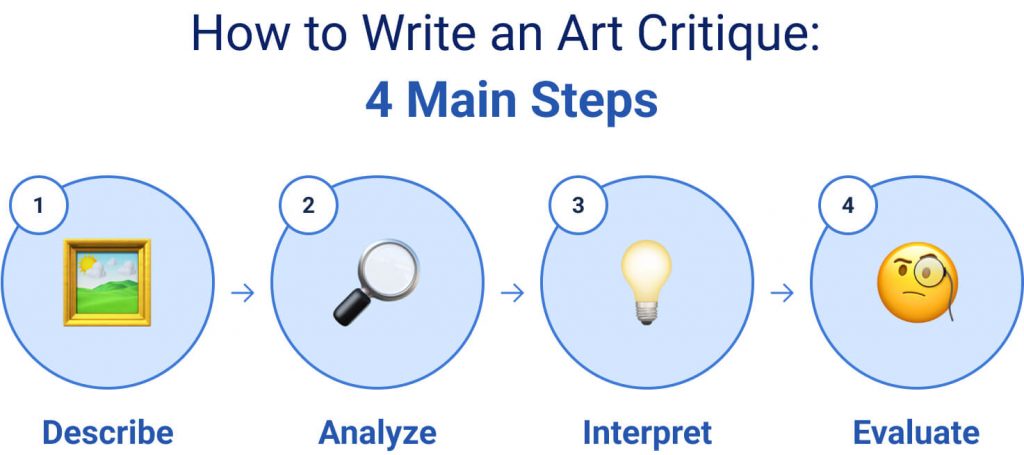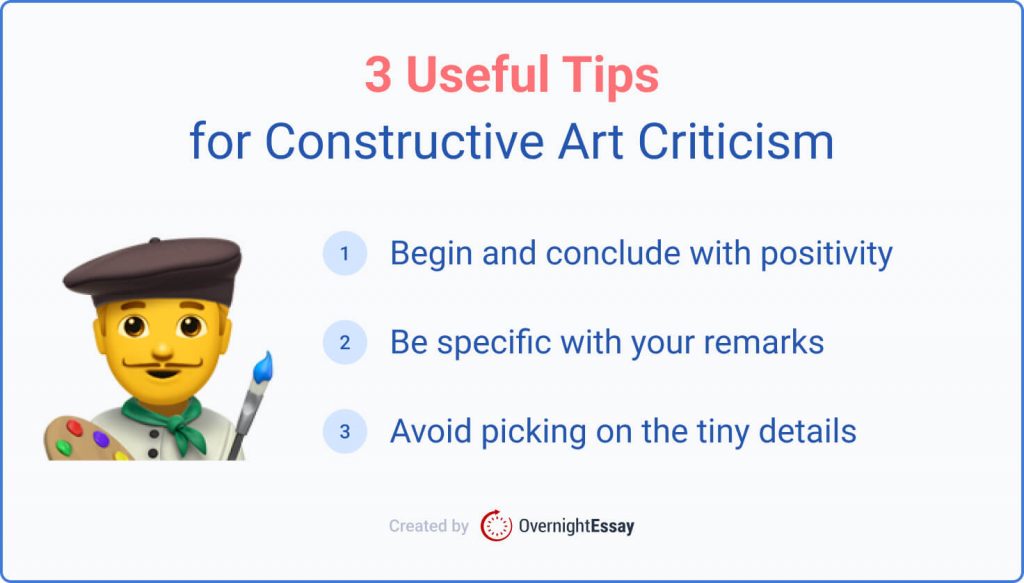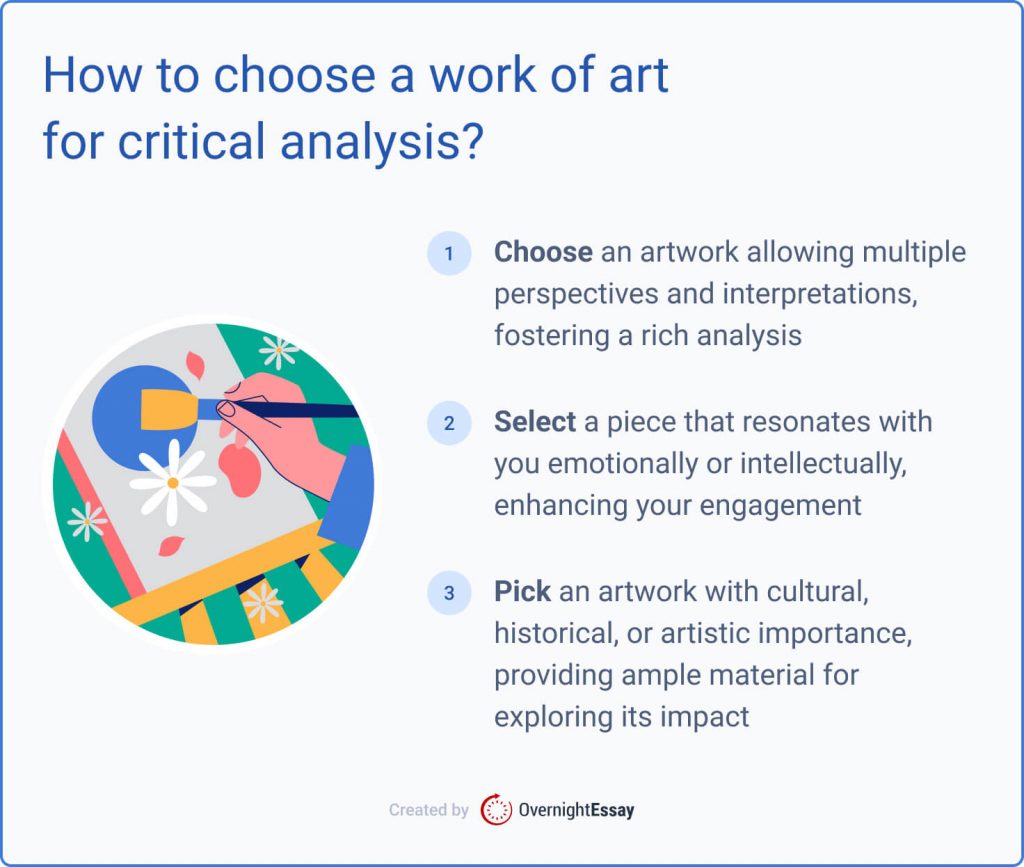
Art is an integral part of the human experience, as it inspires and helps us develop a sense of beauty. It can catch you off guard during a visit to an art gallery or on a forest walk in the autumn. Even such a mundane thing as a sunset can invoke expressive feelings you can’t quite explain. And oftentimes, the emotion spectrum of a painted sunset differs from a photograph. However, writing your critique review about art can be more challenging than admiring it.
We will write a custom paperDon’t stress and fret if you get an art critique assignment and need to improve your skills. Our team has created a guide that contains everything you need to know about writing this type of essay. We will also explain its four components and provide art critique examples that can inspire your own writing.
Table of Contents“Why do you even need to criticize art?” is a legitimate question that you might be asking. Isn’t it enough that someone spent their time and made something? What’s the point of breaking down their work?
While it is true that the word “critique” evokes negative associations, there is more to it than just pointing out an artwork’s flaws. A well put criticism allows you, your audience, and the artist themselves to see the work from a different angle.

A good critique paper provides several things:
In only 3 hours ,An outside opinion of the work. Despite the common misconception, artists love to discuss their creations and those of their peers. A critique provides valuable data for their subsequent artistic pursuits and may point towards things artists didn’t consider because of their limited scope of work.
A better understanding of one’s skills. A well-written art critique never seeks to tear down its subject. Instead, it serves as an assessment of the person’s artistic skills. A good analysis helps them pay attention to unexplored parts of their work.
A new perspective. An artist can grow only when they know what needs improvement. Listening to praise all the time limits their development. A critical paper can point them in a better direction without being obnoxious or judgmental.
A more profound sense of community. An art critique helps artists develop and see themselves from the other side. It makes them more open to discussing their opinions and values. That gives them a better understanding of what motivates and guides others.
An art critique is an outside opinion of the creator’s work that helps them improve their style and techniques. A well-made art critique tells what other people think of the artist’s efforts and draws attention to issues that must be solved, which leads to better professional and personal growth. Additionally, it lets us understand the work of old masters on a deeper level, evaluating where they succeeded or failed.
When you get down to basics, criticizing a creative work is also an art form in itself. That’s why students often struggle to describe works of art, especially if it’s their first time doing so.

When working on a critique, you must include several components we’ll cover later:
Description of the work. Artist’s intentions and analysis. Response and interpretation. Conclusions and evaluation.This approach is also known as the Feldman model and is widely used in art. Let’s look at each part and its role in writing an excellent art critique.
When making an art critique, examining the subject thoroughly is essential. Your first impression and initial response to the piece are critical, so take the time to absorb it. When evaluating an artwork, learn about its background (author, significance, prominent motifs, and techniques.) You can also discuss the work’s medium, brushstrokes, color scheme, or any other relevant details.
Get your very firstNext, address the content of the work: the scene, figures, and objects depicted on the canvas or in the sculpture. You can mention the size of the work, texture, lines, composition, and perspective. If you’re looking for excellent art to examine, check out Caravaggio’s The Calling of St. Matthew. It’s a masterpiece that combines light, shadow, expressions, and movement to tell a story in a single frame.
After you’re done admiring the piece, it’s time to determine what makes it work. When going through your visual findings, try answering the reason behind their use. For example, why did the artist use a particular type of paint or composed the frame in a certain way? It helps to establish an artist’s intent behind their work.
To make a comprehensive art criticism essay, look at the larger context. Learn about the artist, what drove them to create, and the biggest influences on their work. This helps better understand why they chose to create a particular piece during a certain artistic period. For example, Carravagio made some of his best paintings as church commissions, hence the wide use of Christian symbolism in many of his works.
Art critique essays often hyperfocus on the artist and their work, forgetting that, ultimately, spectators are the ones experiencing it. In this part of the analysis, share what feelings the painting or sculpture evokes in your mind. There are no wrong answers here, as everybody sees art from their perspective. Look past what the artist tries to depict and explain the meaning you see behind the art.
When evaluating a work of art, think about what it makes you feel (joy, anger, sadness, and so on.) Next, think about the area or figure that draws your attention. Note the artistic choices that brought the whole thing together. Addressing these things will make your analysis more comprehensive.
We will write a custom paperRemember that a criticism is largely a personal opinion based on your experience and interpretation. The conclusion section of the art criticism essay should also evaluate the effectiveness of the artist’s choices in creating the right impact on the viewers and seeing their vision through. Think about how the artwork made you feel, using personal thoughts and feelings.
Once everything is said, you have to provide a summary of the art piece. Don’t try to imagine what the person could have done with the work. Instead, evaluate what they achieved with it. When working on this part of the essay, analyze the author’s intention, whether they were successful, and whether the piece was worth evaluating.
In addition to this guide, we would like to provide a set of questions that will help you with your art criticism essay. There’s no need to answer all of them in your work, but knowing about them won’t hurt. Whether you’re writing a work about one of the classical pieces or contemporary abstract art, these questions can guide you. They can help you overcome your writer’s block, provide new ideas, or ensure that you stay on the right track.
Is the choice of colors balanced, or do they clash? Where is the horizon line placed, and how does it influence the work? How does the color scheme work to set the piece’s mood? Is the composition set to make the scene look three-dimensional? Are the elements of the art piece positioned the right way? What idea did the artist want to convey in the work? Does the author use light and shadow properly? How does the artist express human emotions? Are there any errors with the composition? What is the main focus of the artwork?Sometimes, it is challenging to describe some details or set the tone for a critical essay. So, we’ve picked tips to help you create the perfect analysis paper.


📌 Make preliminary research to understand different art forms, styles, or movements. It’s beneficial to familiarize yourself with artists’ backgrounds and historical context.
📌 Think about the themes and concepts you want to reveal in your analysis. Do you want to explore the artwork’s symbolism, aesthetic qualities, or historical significance?
📌 Select an artwork that personally resonates with you or piques your interest. A genuine connection with the piece will make the analysis more enjoyable and insightful.
📌 Consider exploring a diverse range of art periods. Analyzing a variety of artworks will broaden your perspective and enhance your critical analysis skills.
Finally, we’d like to offer a list of topics on which you can write your following critical paper. Perhaps here you’ll find something inspiring for your next piece of work.